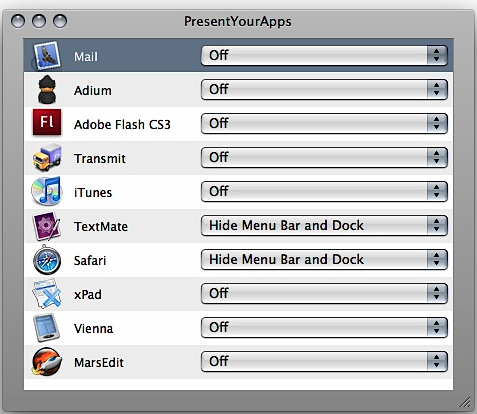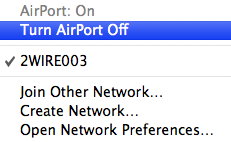Archive
Tip 17: Changing The Dock Theme
LeopardDocks is simple application that changes the Dock Theme. Its straightforward UI makes it very easy to modify your Dock and undo changes. I highly recommend LeopardDocks to anyone who wants to give their dock a little personality.

Dock Themes
On the LeopardDocks website, there is a collection of various Dock themes that can be downloaded.
To Change The Theme
1. Download and Launch LeopardDocks. Download a theme from leoparddocks.com
2. In LeopardDocks, browse for the downloaded theme

3. Select the theme, click “Change My Dock” and confirm the changes with your password.
The Dock theme will now change
– Alexander Garovi
Tip 16: Hide Desktop Clutter
 Want to give your Desktop a new clean look? With Terminal, you can forget about organizing all of your Desktop files and simply hide them. Enter this command in Terminal:
Want to give your Desktop a new clean look? With Terminal, you can forget about organizing all of your Desktop files and simply hide them. Enter this command in Terminal:
chflags hidden ~/Desktop/*
To Undo:
chflags nohidden ~/Desktop/*
This command is very useful, if you don’t want to deal with constantly having Desktop clutter.
– Alexander Garovi
Tip 15: Quick Software Update With Terminal
 Here’s a quick Terminal command that lets you install Apple’s available software updates. There are two sudo commands: one for installing all of Apple’s updates and one for only installing recommended software updates.
Here’s a quick Terminal command that lets you install Apple’s available software updates. There are two sudo commands: one for installing all of Apple’s updates and one for only installing recommended software updates.
All Updates
sudo softwareupdate -i -a
Recommended Updates
sudo softwareupdate -i -r
More quick Terminal tips are on the way.
– Alexander Garovi
4 Ways To Access The StumbleUpon Community
 Want to change internet browsers, but can’t imagine not having a Stumbleupon plugin? Stumbleupon, the popular Internet community that allows users to discover and rate websites, has various ways of being accessed. Users can connect to Stumbleupon through the service’s website along with Internet browser tools. Here are some tools that work with Stumbleupon.
Want to change internet browsers, but can’t imagine not having a Stumbleupon plugin? Stumbleupon, the popular Internet community that allows users to discover and rate websites, has various ways of being accessed. Users can connect to Stumbleupon through the service’s website along with Internet browser tools. Here are some tools that work with Stumbleupon.
1. Opera Stumbler is a third party plugin that allows Opera users to access StumbleUpon. Opera Stumbler is located in Opera’s menu bar and offers all of the features Stumbleupon provides. This tool is free, and easy to install.

2. StumbleUpon for Firefox is a toolbar-based plugin for Firefox that lets you access the Stumbleupon community. This plugin allows you to stumble, send messages, rate pages and more. StumbleUpon for Firefox is free to download.
![]()
3. Stumbi for Safari is a lightweight plugin that is situated next to the back-forward buttons and Safari’s menu bar. This plugin gives you the ability to vote, send messages to friends and more. Stumbi costs $4, but you can download a free trial with 100 stumbles.


4. You can also access the Stumbleupon community on the service’s website. Stumbleupon offers a virtual toolbar that allows you to access all of the features that would be in a toolbar app. This method is great if you don’t want to deal with installing browser plugins.
![]()
– Alexander Garovi
Tip 14: More Frequent Auto Saves In Microsoft Word
 Here’s another Microsoft Word Tip. Saving your work is always important, in order to prevent frustrating data loss. Luckily, if you sometimes forget to save, Word auto saves your progress at a default setting of every 10 minutes. You can even shorten this amount of time and make auto saves more frequent. Here’s how you do it:
Here’s another Microsoft Word Tip. Saving your work is always important, in order to prevent frustrating data loss. Luckily, if you sometimes forget to save, Word auto saves your progress at a default setting of every 10 minutes. You can even shorten this amount of time and make auto saves more frequent. Here’s how you do it:
1. Open Microsoft Word
2. With a document open, go File > System Preferences (Command-,)
3. In the Output and Sharing section, select Save
4. You will see a checkbox next to “Save AutoRecover info every (set amount of time) minutes”
![]()
5. Enter the amount of time between auto saves
Note: I believe you have to save one time manually, before the auto save function works.
This tip concludes today’s Microsoft Word tips.
– Alexander Garovi
Tip 13: Changing The Default Font In Microsoft Word
 If you want to give your docs a new look, changing the default font is very easy to do. Here’s how you do it:
If you want to give your docs a new look, changing the default font is very easy to do. Here’s how you do it:
1. Open Microsoft Word
2. Open a document, or create a New Blank Document
3. Go Format > Font (Command-D)
4. Select the font, size, font styles etc.
5. On the bottom-left hand corner of the window, click Default
6. A box asking if you want to change the default font will appear. Click Yes

Your default font will now be the selected one. More quick Microsoft Word tips are on the way.
– Alexander Garovi
Tip 12: Renaming Bootcamp Partitions
Tired of seeing the name, “untitled” under your Bootcamp partition? With a few easy steps, you can change it to something more interesting. Before changing the partition’s name, you must reboot into Windows. Unable to take screenshots in Windows, I was forced to use my camera :-/. Here’s how you do it:
1. Reboot into Windows
2. Go Start > My Computer
3. You will see the C: named “UNTITLED”.

4. Highlight the HD’s name, enter a new name and press Enter

5. Reboot in OS X and you should see your partition with its new name. The only issue with this tweak is that the new name will be in caps.
Before:

After:

I personally don’t use a name at all – At startup in OS X, highlight the partition’s name and press Spacebar and Enter. This must be done in OS X, because Windows doesn’t permit empty Disk names. At the computer’s next startup, the name will be changed back to “Untitled”.

– Alexander Garovi
6 Ways To Stay Focused On Your Work
Sometimes, when there’s an important paper or project that needs to be finished, your Mac can be the biggest thing in your your way from working productively. Accessing the consuming websites and apps we all use can be very distracting. Here are some apps and tips to help you stay focused on your work.

1. Think allows you to limit your attention to any one application and easily change focus if necessary. Think uses an Illumination Panel, allowing you to choose an application on which to focus. The Think Backdrop shields you from outside distractions, as the Desktop and other applications are hidden behind it to keep you focused on your work. Think is a free app and can be downloaded here.

2. Concentrate helps you work more productively by getting rid of distractions. Concentrate allows you to create activities and select actions that correspond to each activity. With Concentrate, you can quit any distracting apps, block distracting websites, add sound alerts, make sound messages to keep you on task, run scripts to remove any unique distractions and more. Concentrate’s 60 hour free trial is available for download here.

3. WriteRoom is a distraction free writing program that emulates the simplicity of the typewriter. WriteRoom offers different colors, fonts, page layouts, an optional scroll-bar and optional spell-checking. With WriteRoom, its just you and the text without any distractions. WriteRoom’s free trail can be downloaded here.

4. PresentYourApps is an application that allows you hide the Dock and menu bar. PresentYourApps opens up a lot of extra screen space that allows you to work better. PresentYourApps is free and can be downloaded here.

5. Spaces is a great component of OS X Leopard that allows you to assign applications to individual desktop Spaces. It is a great way to keep your desktop organized and keep you focused on the apps you’re using. For example, I assigned a space to my productivity applications such as Word, Excel etc. and a separate one to my internet browsers to keep me focused on my work. Spaces can be set up in System Preferences in the Exposé and Spaces section.

6. Turn off your Airport – If you’re like me, you repeatedly switch off between accessing the internet and working. If you have to force yourself to work, I’d suggest turning off your Airport completely.
This concludes today’s tips on staying focused in OS X.
– Alexander Garovi
Tip 11: Keep Your Screen From Dimming With Caffeine

Sometimes it’s nice to have a fully lit screen that doesn’t dim down. Lighthead’s Caffeine is the perfect solution to prevent your Mac from falling asleep. Caffeine is a tiny application that is situated in the menu bar. Simply click on the mug icon and your Mac will not start screen savers or dim the screen. You can also set a time limit from five minutes to two hours for Caffeine to run. Caffeine is definitely one of my favorite OS X apps and I highly recommend it to all Mac users. It’s a free download and can be found on the Free Apps page.

Caffeine allows you to set the amount of time it runs for
– Alexander Garovi
Tip 10: Quick Picture Converting With Preview

Have a picture that you want to convert into a different format? With a couple clicks you can convert a picture to your desired type with OS X’s Preview. Here’s how you do it:
1. Open the picture in Preview
2. Go File > Save As
3. From here, there are numerous photo formats you can save your picture as

Using Preview as an image converter is a lighter alternative to using Photoshop any other large photo editing programs to change a photo type. Sometimes photo conversion is especially necessary when uploading pictures to some websites that only take certain photo formats.
– Alexander Garovi
